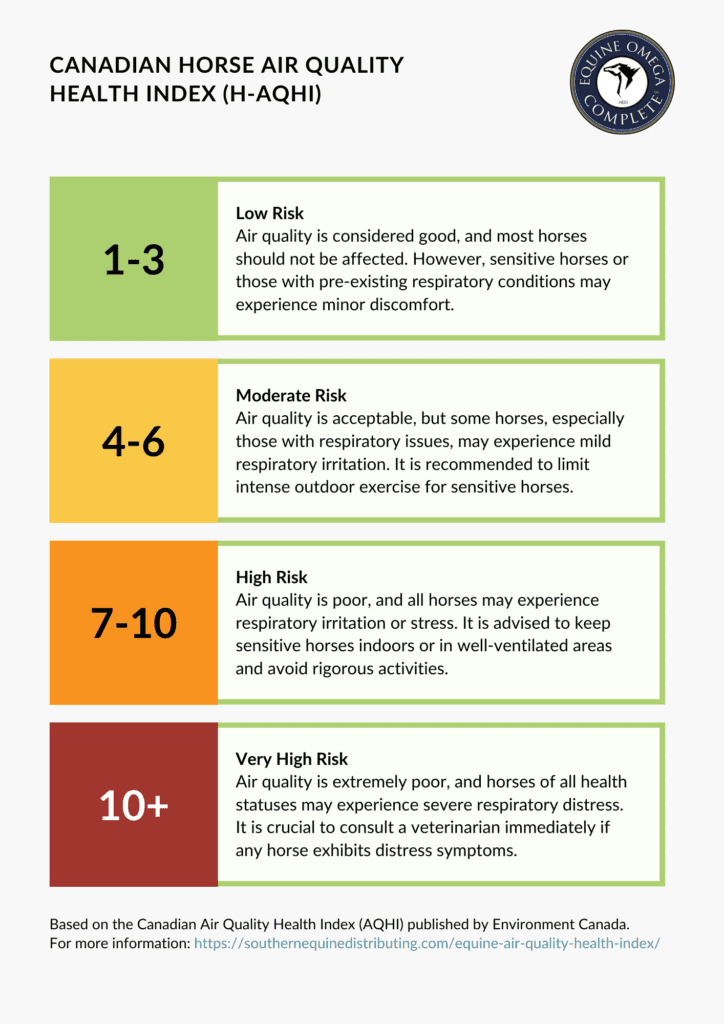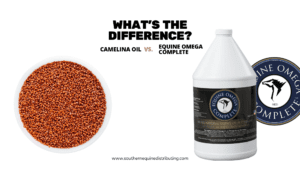How to Read the Equine Air Quality Health Index and Proper Management Strategies
As horse owners, we cherish our equine companions’ well-being and strive to provide them with the best care possible. One aspect that can significantly impact our horses’ health is the air quality they breathe. Whether it’s urban pollution, allergens, or the increasing concern of forest fire smoke, understanding and managing air quality is crucial in safeguarding our horses’ respiratory health. In this comprehensive guide, we’ll explore the Canadian Horse Air Quality Health Index (H-AQHI) and how it can help us navigate air quality challenges for our beloved horses.
The Horse Air Quality Index (H-AQHI)
The Canadian Horse Air Quality Health Index (H-AQHI) is a valuable tool designed specifically for equine enthusiasts. It utilizes the Canadian AQHI scale, ranging from 1 to 10+, to assess air quality conditions in your area. This index considers various pollutants, including particulate matter, ground-level ozone, nitrogen dioxide, sulphur dioxide, and carbon monoxide. It provides an easy-to-understand reading to help horse owners make informed decisions about their horses’ well-being.
AQHI Scale for Horses
1-3: Low Risk
Air quality is considered good, and most horses should not be affected. However, sensitive horses or those with pre-existing respiratory conditions may experience minor discomfort.
4-6: Moderate Risk
Air quality is acceptable, but some horses, especially those with respiratory issues, may experience mild respiratory irritation. For most horses, moderate outdoor activities can be continued as usual. However, if your horse has a history of respiratory conditions or sensitivity, consider reducing the intensity or duration of their exercise.
7-10: High Risk
Air quality is poor, and all horses may experience respiratory irritation or stress. It is advised to keep sensitive horses indoors or in well-ventilated areas and avoid rigorous activities. Reduce the intensity and duration of outdoor activities for all horses during this AQHI level. If your horse has pre-existing respiratory issues or allergies, limiting their outdoor exposure and keeping them in a well-ventilated, dust-free environment is best.
10+: Very High Risk
Air quality is extremely poor, and horses of all health statuses may experience severe respiratory distress. Avoid all outdoor activities and exercises during these severe air quality conditions. If possible, keep horses indoors with good ventilation and consult a veterinarian immediately if any horse exhibits distress symptoms.
Factors Considered in H-AQHI Calculation:
The H-AQHI considers several key factors that contribute to air quality and affect horses’ well-being:
Particulate Matter (PM2.5 and PM10): Fine and coarse particles suspended in the air can irritate the respiratory system and exacerbate existing health conditions.
Ground-Level Ozone (O3): Ozone can be harmful when inhaled, particularly for horses with respiratory sensitivities.
Nitrogen Dioxide (NO2): High levels of NO2 can lead to airway inflammation and increased respiratory issues in horses.
Sulphur Dioxide (SO2): SO2 can cause respiratory irritation and exacerbate pre-existing lung conditions in horses.
Carbon Monoxide (CO): CO can reduce the blood’s ability to carry oxygen, impacting horses’ overall health and performance.
The Impact of Forest Fire Smoke
As forest fires become more frequent and severe, their smoke poses a significant threat to equine respiratory health. Fine particulate matter and harmful gases released during wildfires can lead to respiratory distress and exacerbate pre-existing conditions. Monitoring the H-AQHI during such events becomes crucial in understanding how the air quality may be affecting our horses.
Using the H-AQHI
To access the current H-AQHI for your area, you can visit the official Canadian AQHI website or use local air quality monitoring stations. Remember that weather conditions and environmental factors can change rapidly, so checking the AQHI regularly is essential, especially during extreme weather events or forest fires, which may significantly impact air quality.
Using the H-AQHI, horse owners and caretakers can make informed decisions to protect their equine companions from potential respiratory issues and ensure their well-being during varying air quality conditions.
Note: The H-AQHI is intended for informational purposes and should not replace professional veterinary advice. If you notice any signs of respiratory distress or discomfort in your horse, seek immediate veterinary attention.
Preventative Measures for High H-AQHI
Preventing exposure to poor air quality is the first line of defense for our horses’ respiratory health. Here are some measures to consider:
a. Limit Outdoor Activities: On days when the H-AQHI indicates a high risk (High or Very High), reduce or avoid strenuous outdoor activities with your horses. Engage in lighter exercises or consider keeping them indoors if possible.
b. Proper Ventilation: Ensuring proper ventilation in barns and stables can help reduce indoor air pollution. Adequate airflow helps disperse airborne contaminants and improves overall air quality for your horses.
c. Avoid High-Traffic Areas: If your stables are located near busy roads, keep horses away from areas with heavy traffic. Vehicle emissions can contribute to poor air quality and increase health risks.
Management Strategies for High H-AQHI
While preventative measures are essential, some management strategies can be adopted during periods of high AQHI:
a. Soaking Hay: Soaking hay before feeding can help minimize dust particles, reducing the risk of respiratory irritation.
b. Electrolyte Supplementation: During hot and humid conditions, providing horses with electrolytes can help maintain hydration and support overall well-being.
c. Monitoring Water Consumption: Keep a close eye on your horse’s water intake during high AQHI periods. Encourage them to drink more water to stay hydrated.
d. Schedule Riding Times Wisely: If riding is necessary, try to schedule sessions during cooler and less polluted times of the day, such as early mornings or late evenings.
Conclusion
Air quality is a critical factor in preserving our horses’ respiratory health and overall well-being. By utilizing the Canadian Horse Air Quality Health Index (H-AQHI), we can proactively monitor and respond to changing air quality conditions. Incorporating preventative measures and management strategies during periods of high AQHI allows us to protect our equine companions and ensure their safety and comfort even during challenging times.






